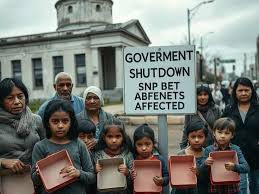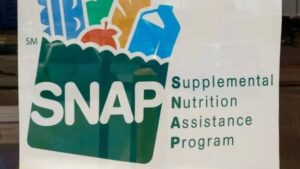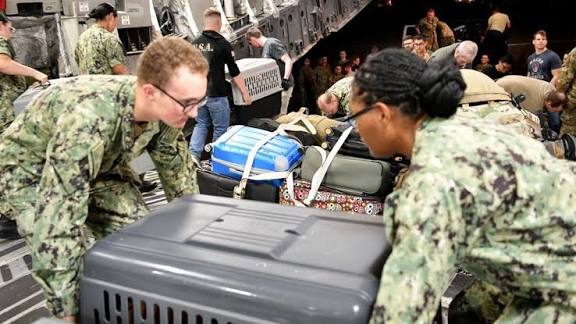Government shutdown food stamps: USDA announces,SNAP benefits,stopped due to,California

The government shutdown is halting SNAP benefits for about 42 million Americans through November 1, 2025. Today we will discuss about Government shutdown food stamps: USDA announces,SNAP benefits,stopped due to,California
Government shutdown food stamps: USDA announces,SNAP benefits,stopped due to,California
In October 2025, the United States faced another federal government shutdown after lawmakers in Congress failed to reach an agreement on a new spending plan. The immediate impact rippled across federal agencies, with one of the most significant consequences being the potential halt of the Supplemental Nutrition Assistance Program (SNAP) — more commonly known as food stamps.
Millions of Americans, including over 5.5 million Californians who depend on CalFresh, the state’s version of SNAP, are at risk of missing out on their November benefits. The United States Department of Agriculture (USDA) announced that due to the funding lapse, the department no longer has the authority to issue November food stamp payments unless Congress approves new spending.
This article examines how the government shutdown is affecting SNAP benefits, why California is especially vulnerable, what the USDA has announced, and what recipients can do to prepare.
What is SNAP and Why It Matters

The Supplemental Nutrition Assistance Program (SNAP) is the nation’s largest food assistance initiative, providing monthly funds to help low-income households purchase nutritious food. Recipients access their benefits through an Electronic Benefit Transfer (EBT) card, which functions like a debit card at authorized grocery stores and markets.
In 2024, the average household benefit under SNAP was around $330 per month, which may not sound like much, but it is often the difference between a family having meals on the table or going hungry. SNAP also acts as an economic stabilizer — for every dollar distributed, approximately $1.50 circulates back into the economy through grocery stores, farmers, and food suppliers.
In California, the program is known as CalFresh and helps over 5.5 million people. For many, it is not just a safety net but a lifeline. Given California’s high cost of living, especially for food and housing, even a short interruption in benefits can create a serious crisis.
How the Shutdown Impacts Food Stamps
SNAP is fully funded by the federal government. While states administer the program, the money for benefits flows from federal appropriations passed by Congress. When the government shuts down, that flow stops.
Under federal law, the USDA cannot issue benefits if Congress fails to authorize spending. The department does have a small contingency fund, but that money is reserved for emergencies or previously appropriated benefits, not for issuing new monthly payments.
As of late October 2025, the USDA has notified state agencies that November SNAP benefits may not be issued if the shutdown continues. Officials said that the funds available are not sufficient to cover the more than 42 million Americans who rely on the program.
This means that by November 1st, many families could find their EBT cards empty — an unprecedented situation that would immediately increase hunger across the country.
The Situation in California: CalFresh on the Brink
Scale of the Problem
California faces a particularly serious situation. The state has one of the highest numbers of SNAP participants in the country, with around 5.5 million people depending on CalFresh every month. The state’s high food and housing costs mean that many residents already live paycheck to paycheck, relying on food assistance to bridge the gap.
If CalFresh benefits are delayed or stopped altogether, billions of dollars in local economic activity could be lost in just a few weeks. Grocery stores, farmers’ markets, and food producers all depend on these funds circulating through their communities.
State and Local Response
The California Department of Social Services has warned counties that November CalFresh payments could be delayed. The Attorney General of California has demanded answers from the USDA, expressing concern that millions of Californians are facing food insecurity if funds are not restored.
Local organizations are also taking action. Food banks across the state — from Los Angeles to Fresno to San Diego — are preparing for a sharp surge in demand. Some counties have started public awareness campaigns advising residents to stretch their current benefits as long as possible and stock up on shelf-stable foods before the shutdown’s effects are fully felt.
Why This Shutdown Is Different
Government shutdowns have happened before, but this time the stakes are higher. During previous shutdowns, such as in 2018–2019, the USDA used contingency funds to issue benefits temporarily. However, legal reviews later determined that doing so without Congressional approval violated federal law.
Now, with the USDA facing tighter restrictions, the agency has said it will not issue benefits without proper funding authorization. Combined with rising food prices, larger caseloads, and limited savings among low-income households, the potential consequences are far greater than in past shutdowns.
This is why hunger-relief advocates describe the current situation as a “man-made disaster in the making.”
Economic Consequences
The loss of SNAP benefits is not only a humanitarian crisis but also an economic one. When low-income families cannot spend their food dollars, local economies suffer.
-
Reduced consumer spending: Grocery stores, especially in low-income neighborhoods, rely heavily on SNAP dollars. A sudden stop means less business for local shops and markets.
-
Job losses: Retail workers, farm employees, and food-distribution staff could face reduced hours or layoffs.
-
Economic ripple effect: Economists estimate that every $1 in SNAP spending produces about $1.50 in local economic activity. A one-month interruption could mean hundreds of millions in lost spending in California alone.
The food-assistance network also becomes strained. Food banks may need to feed twice or three times their usual number of families, stretching limited donations and volunteers to their limits.
Human and Social Impact
Beyond economics, the most immediate consequence is hunger. Food insecurity rises quickly when benefits stop, especially for children, seniors, and people with disabilities.
-
Health risks: Poor nutrition leads to weakened immune systems, higher medical costs, and long-term health issues.
-
Educational setbacks: Hungry children struggle to concentrate in school, impacting learning and development.
-
Emotional toll: Uncertainty about where the next meal will come from adds stress and anxiety for millions of families.
For those already living on the edge, even a delay of a few days can mean skipping meals or turning to food banks for emergency assistance.
What USDA Has Announced
The USDA has issued internal guidance to all states stating that:
-
Contingency funds are not available to issue new benefits during the funding lapse.
-
States are instructed to hold all November benefit files until further notice.
-
Without Congressional action, there are insufficient funds to pay full benefits to over 42 million SNAP participants nationwide.
This announcement effectively signals a halt to the program if the shutdown persists. For states like California, this means that CalFresh recipients may see no funds added to their EBT cards starting November 1st unless Congress acts quickly.
What CalFresh and SNAP Recipients Should Do
While households cannot control the outcome in Washington, there are practical steps recipients can take to prepare for potential disruptions.
-
Stay informed:
Monitor your local county social services website or call the CalFresh information line. Many counties issue text or email alerts about benefit schedules. -
Budget wisely:
Use October benefits carefully. Focus on shelf-stable items like rice, beans, pasta, canned vegetables, and other essentials that can stretch for several weeks. -
Seek local food resources:
-
Call 2-1-1 for local food bank information.
-
Visit community centers, churches, and nonprofits offering free groceries or meals.
-
Some school districts provide free breakfasts and lunches for children even during shutdowns.
-
-
Avoid scams:
Never share your EBT card number or PIN with anyone claiming they can “restore” your benefits. Only trust official government communications. -
Plan for the worst:
If possible, set aside a small portion of funds for emergency groceries or transportation to food-bank sites.
What Food Banks and Communities Can Do
Local organizations play a critical role in cushioning the blow during shutdowns.
-
Stock up early: Anticipate higher demand from households missing SNAP benefits.
-
Expand outreach: Inform the public about available food resources and distribution times.
-
Coordinate with counties: Work with local governments to share data and ensure fair distribution.
-
Recruit volunteers and donations: Encourage community members to help pack or distribute food.
-
Advocate for policy solutions: Use this crisis to highlight the importance of protecting essential nutrition programs from political gridlock.
Political and Legal Dimensions
The food-stamp crisis has become a political flashpoint. The USDA has stated that its hands are tied legally, pointing to Congress for failing to provide funds. In turn, state leaders argue that the agency could have done more to plan for contingencies.
Legal experts note that during the 2019 shutdown, the USDA technically violated federal law by issuing benefits without authorization. To avoid repeating that error, the department is now taking a stricter stance.
The standoff illustrates a larger problem: vital programs like SNAP are hostage to budget politics. Every shutdown creates uncertainty for millions who depend on these benefits, undermining trust in government institutions.
Possible Scenarios Ahead
Scenario 1: Congress Acts Quickly
If lawmakers reach a funding agreement before the end of October, USDA operations resume, and SNAP benefits will be distributed on time. Households may experience minor delays, but the crisis will be avoided.
Scenario 2: Shutdown Extends into November
If no deal is reached, November SNAP benefits will not be issued on schedule. Families could face weeks without food assistance, creating immediate hunger spikes and economic strain across communities.
Scenario 3: Partial Funding or Delayed Issuance
Congress might approve partial funding or a temporary extension, leading to delayed or reduced benefit payments. While better than a full stop, this scenario still leaves families uncertain and food banks overwhelmed.
California’s Emergency Preparedness
California leaders are exploring short-term solutions to cushion the blow:
-
Using limited state emergency funds to support food banks.
-
Coordinating with nonprofit networks to deliver free groceries.
-
Encouraging schools to keep meal programs running.
-
Launching statewide public-awareness campaigns urging recipients to budget and prepare.
However, state officials admit that California cannot replace the federal funding that fuels CalFresh. The scale of the program — billions per year — is too large for the state to sustain independently.
Long-Term Implications
The recurring threat of benefit disruption raises an important policy question: should essential programs like SNAP be insulated from government shutdowns?
Some lawmakers have proposed automatic funding extensions for core safety-net programs, ensuring that families are not left hungry during political gridlock. Others call for multi-year appropriations for programs like SNAP, avoiding the need for annual renewal.
The current crisis may renew those discussions, especially if families start missing benefits in November.
How Communities Can Stay Resilient
Even amid uncertainty, communities can strengthen their response systems.
-
Partnerships: Local governments, nonprofits, and faith organizations can collaborate to share resources.
-
Food recovery programs: Redirecting surplus food from restaurants, farms, and retailers can help fill gaps.
-
Public education: Teaching households about budgeting, food storage, and nutrition ensures limited resources go further.
-
Community gardens and pantries: Expanding local food production and distribution builds long-term resilience.
A coordinated, compassionate response can reduce the hardship many families face during shutdowns.
Why This Matters for Every American
Food assistance is not a partisan issue — it’s a public health and economic issue. When families can afford groceries, communities thrive. When benefits stop, everyone feels the impact, from local grocers to schools to healthcare systems.
The 2025 shutdown highlights the fragility of essential programs that millions take for granted. Without quick action, the nation could witness a historic surge in hunger — not because of natural disaster, but because of political inaction.
Conclusion
The ongoing government shutdown has placed the SNAP/CalFresh program at the center of a national crisis. The USDA’s announcement that benefits cannot be issued without new funding means millions of Americans could lose access to food assistance as early as November 1st.
In California, where 5.5 million people depend on CalFresh, the situation is especially dire. Families are being urged to budget carefully, food banks are preparing for record demand, and state leaders are demanding federal clarity.
Whether this becomes a temporary delay or a full-scale suspension depends entirely on Congress. What’s certain is that the consequences of inaction will be swift and severe — affecting not just the most vulnerable, but the entire economy.
The message from this crisis is clear: food security should never be subject to politics. Until lasting protections are built into the system, millions of Americans will continue to face fear and uncertainty every time the government gridlocks.
How useful was this post?
Click on a star to rate it!
Average rating 0 / 5. Vote count: 0
No votes so far! Be the first to rate this post.
About the Author
usa5911.com
Administrator
Hi, I’m Gurdeep Singh, a professional content writer from India with over 3 years of experience in the field. I specialize in covering U.S. politics, delivering timely and engaging content tailored specifically for an American audience. Along with my dedicated team, we track and report on all the latest political trends, news, and in-depth analysis shaping the United States today. Our goal is to provide clear, factual, and compelling content that keeps readers informed and engaged with the ever-changing political landscape.



